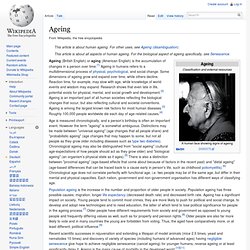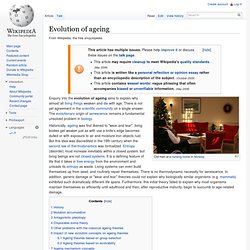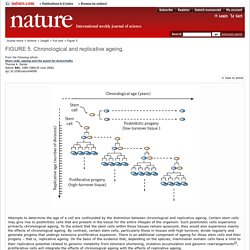

Ageing. Ageing (British English) or aging (American English) is the accumulation of changes in a person over time.[1] Ageing in humans refers to a multidimensional process of physical, psychological, and social change.

Some dimensions of ageing grow and expand over time, while others decline. Reaction time, for example, may slow with age, while knowledge of world events and wisdom may expand. Research shows that even late in life, potential exists for physical, mental, and social growth and development.[2] Ageing is an important part of all human societies reflecting the biological changes that occur, but also reflecting cultural and societal conventions.
Ageing is among the largest known risk factors for most human diseases.[3] Roughly 100,000 people worldwide die each day of age-related causes.[4] Age is measured chronologically, and a person's birthday is often an important event. Population ageing is the increase in the number and proportion of older people in society. Senescence[edit] Ageing. Ageing and Life-Course. Global strategy and action plan on ageing and health To ensure adults live not only longer but healthier lives, a Global strategy and action plan on ageing and health was adopted in May 2016 by the World Health Assembly.

This Strategy focuses on five strategic objectives and is a significant step forward inestablishing a framework to achieve Healthy Ageing for all. It includes a call for countries to commit to action, and developage-friendly environments. It also outlines the need to align health systems to the needs of older people, and the development of sustainable and equitable systems of long-term care. It emphasises the importance of improved data, measurement, and research,and involving older people in all decisions that concern them. Read about the Global strategy and action plan World report on ageing and health 2015 Comprehensive public health action on population ageing is urgently needed. Read the Report and related materials International Day of Older Persons 2016. Evolution of ageing. Enquiry into the evolution of ageing aims to explain why almost all living things weaken and die with age.

There is not yet agreement in the scientific community on a single answer. The evolutionary origin of senescence remains a fundamental unsolved problem in biology. Historically, ageing was first likened to "wear and tear": living bodies get weaker just as with use a knife's edge becomes dulled or with exposure to air and moisture iron objects rust.
But this idea was discredited in the 19th century when the second law of thermodynamics was formalized. Entropy (disorder) must increase inevitably within a closed system, but living beings are not closed systems. History[edit] August Weismann was responsible for interpreting and formalizing the mechanisms of Darwinian evolution in a modern theoretical framework. Mutation accumulation[edit] The first modern, successful theory of mammal aging was formulated by Peter Medawar in 1952. Medawar's theory is referred to as Mutation Accumulation. Types of Ageing. Tissue heterogeneity and stem-cell functionality for homeostasis and repair. Chronological and replicative ageing. Attempts to determine the age of a cell are confounded by the distinction between chronological and replicative ageing.

Certain stem cells may give rise to postmitotic cells that are present in the tissue for the entire lifespan of the organism. Such postmitotic cells experience primarily chronological ageing. To the extent that the stem cells within those tissues remain quiescent, they would also experience mainly the effects of chronological ageing. By contrast, certain stem cells, particularly those in tissues with high turnover, divide regularly and generate progeny that undergo extensive proliferative expansion.
There is an additional component of ageing for those stem cells and their progeny – that is, replicative ageing. Ageing of Stem Cell Functionality. Manifestations of ageing and homeostatic defences.